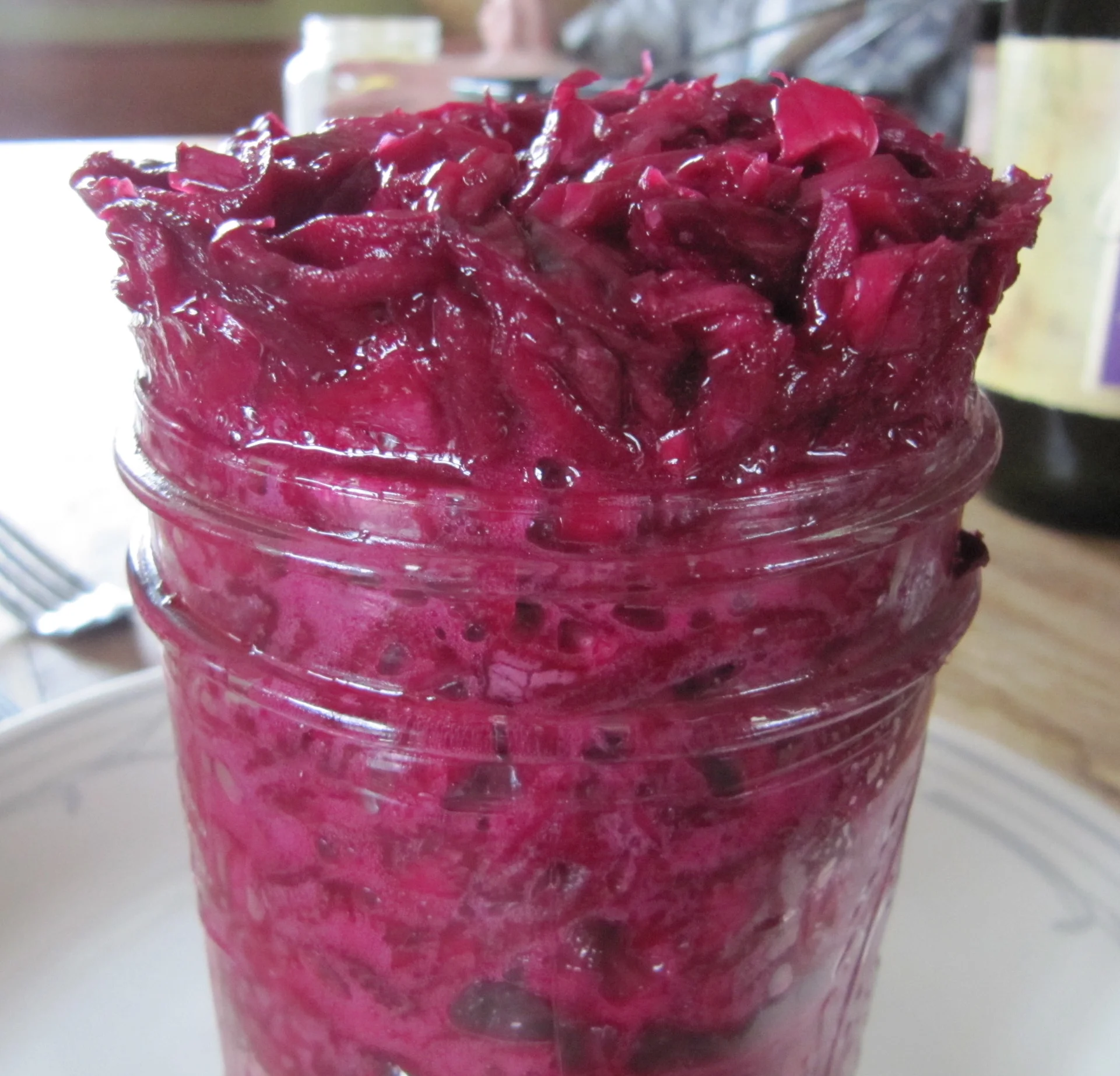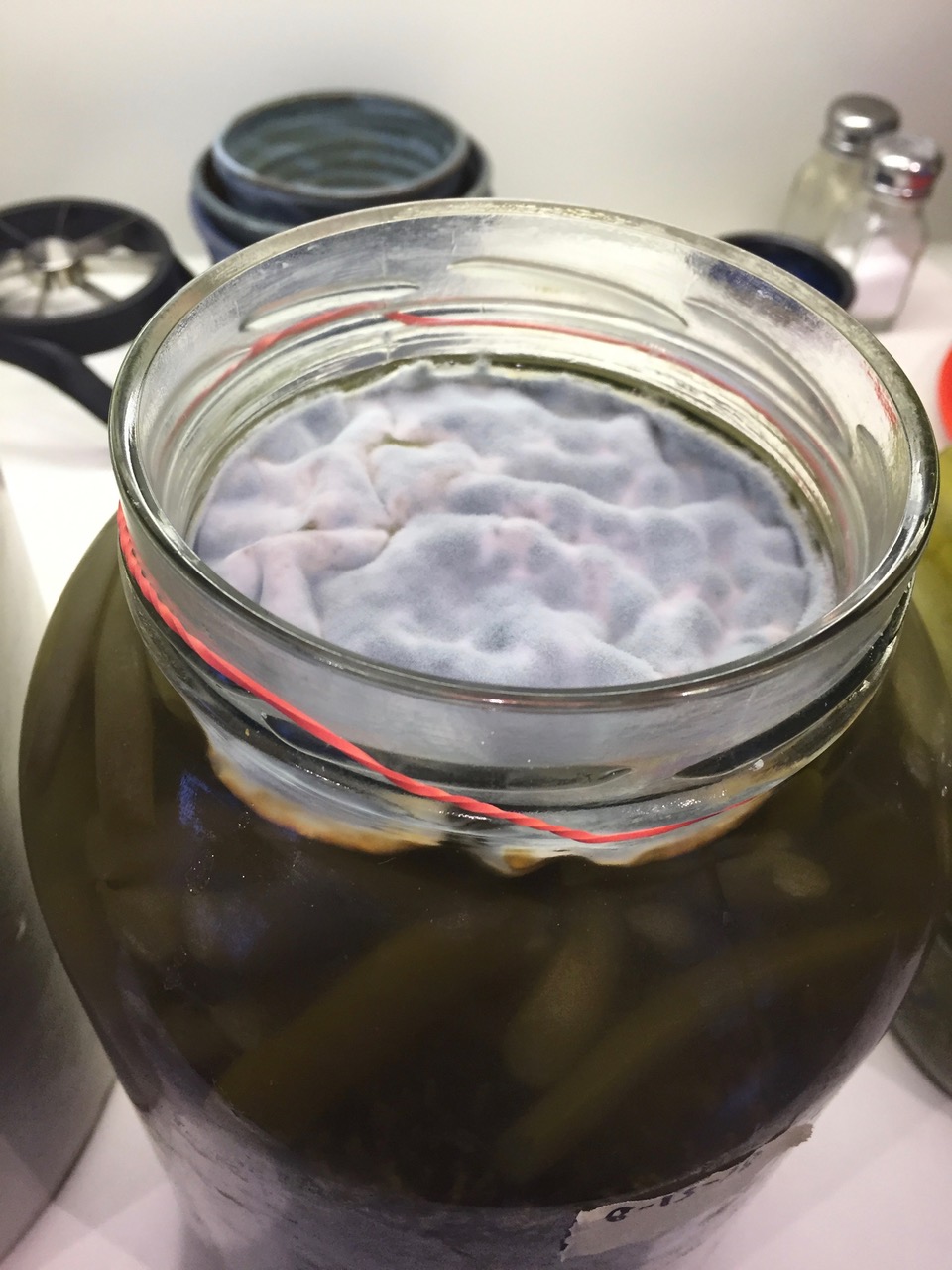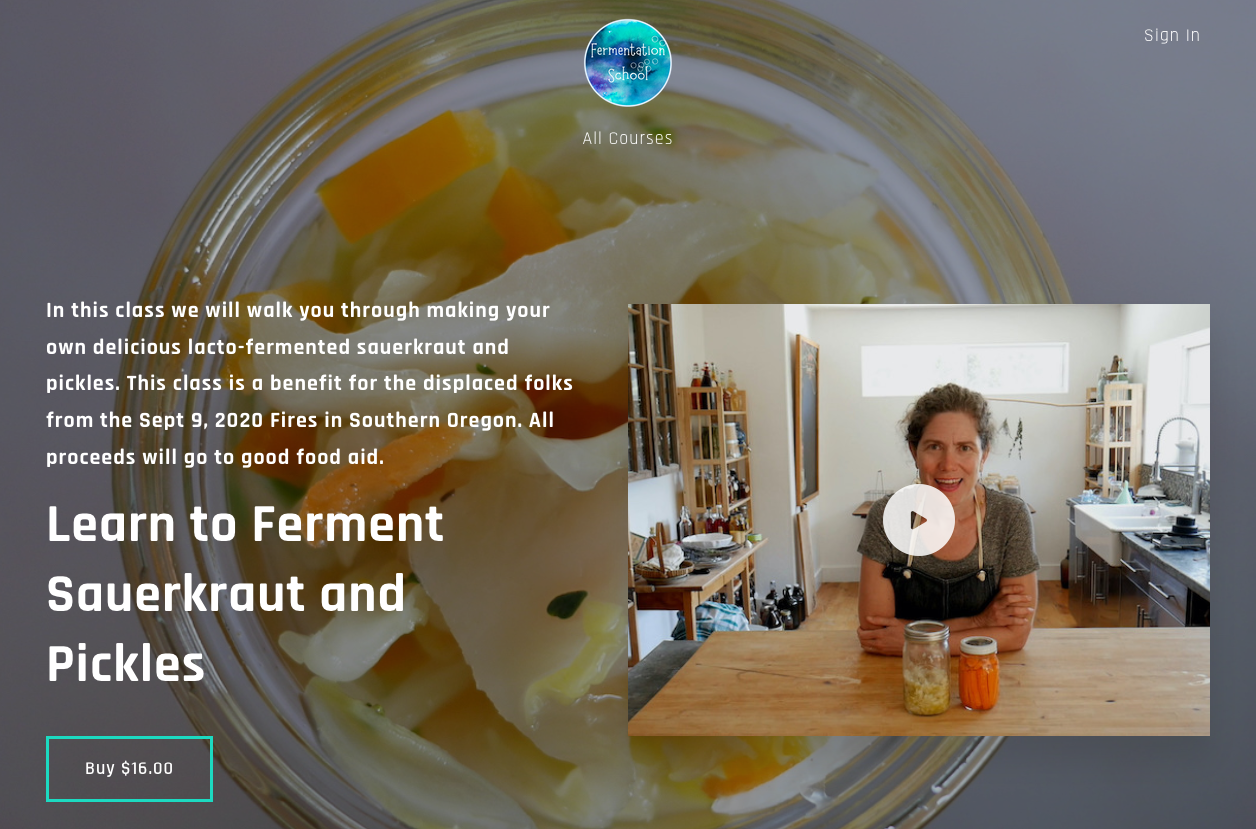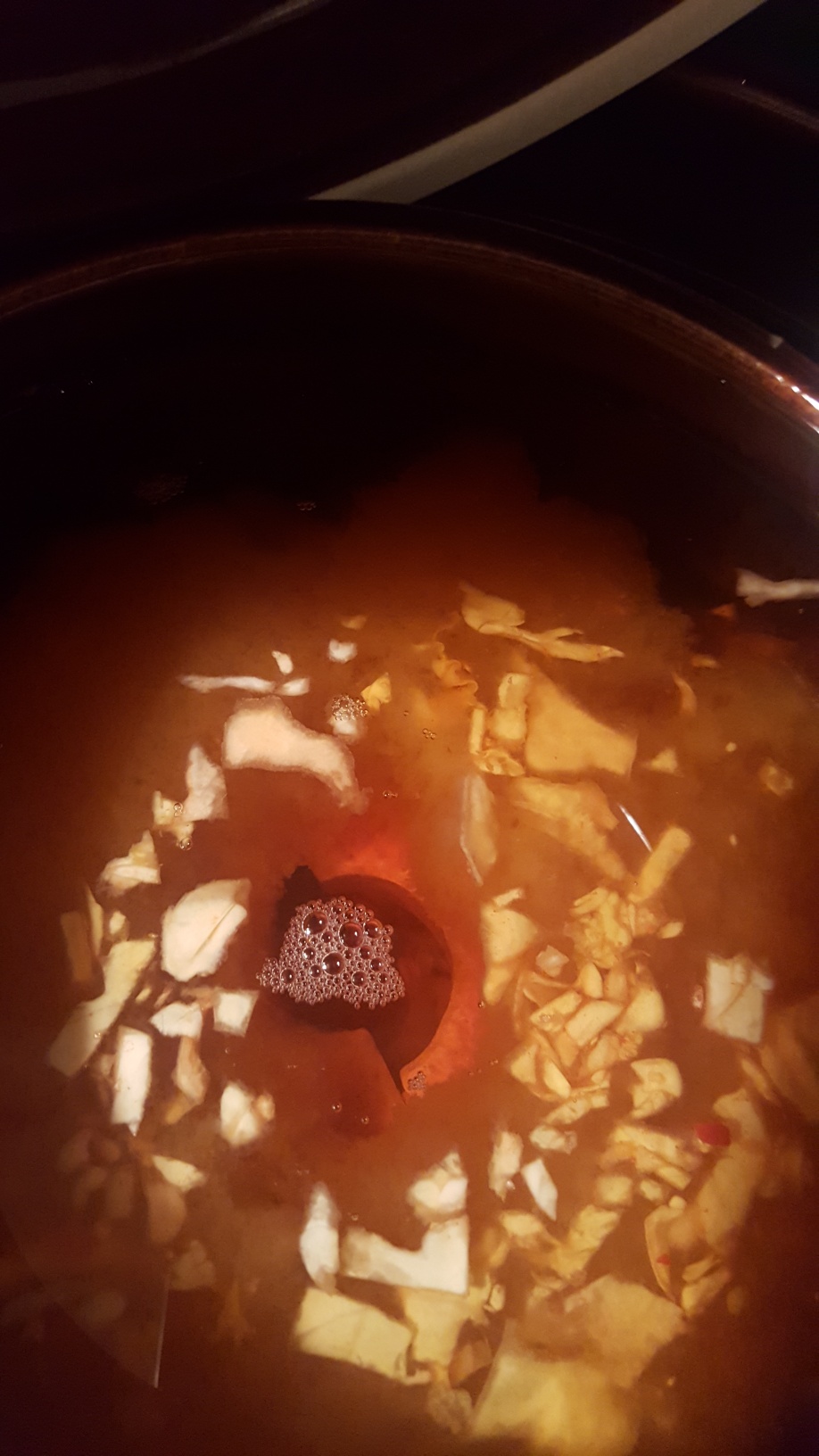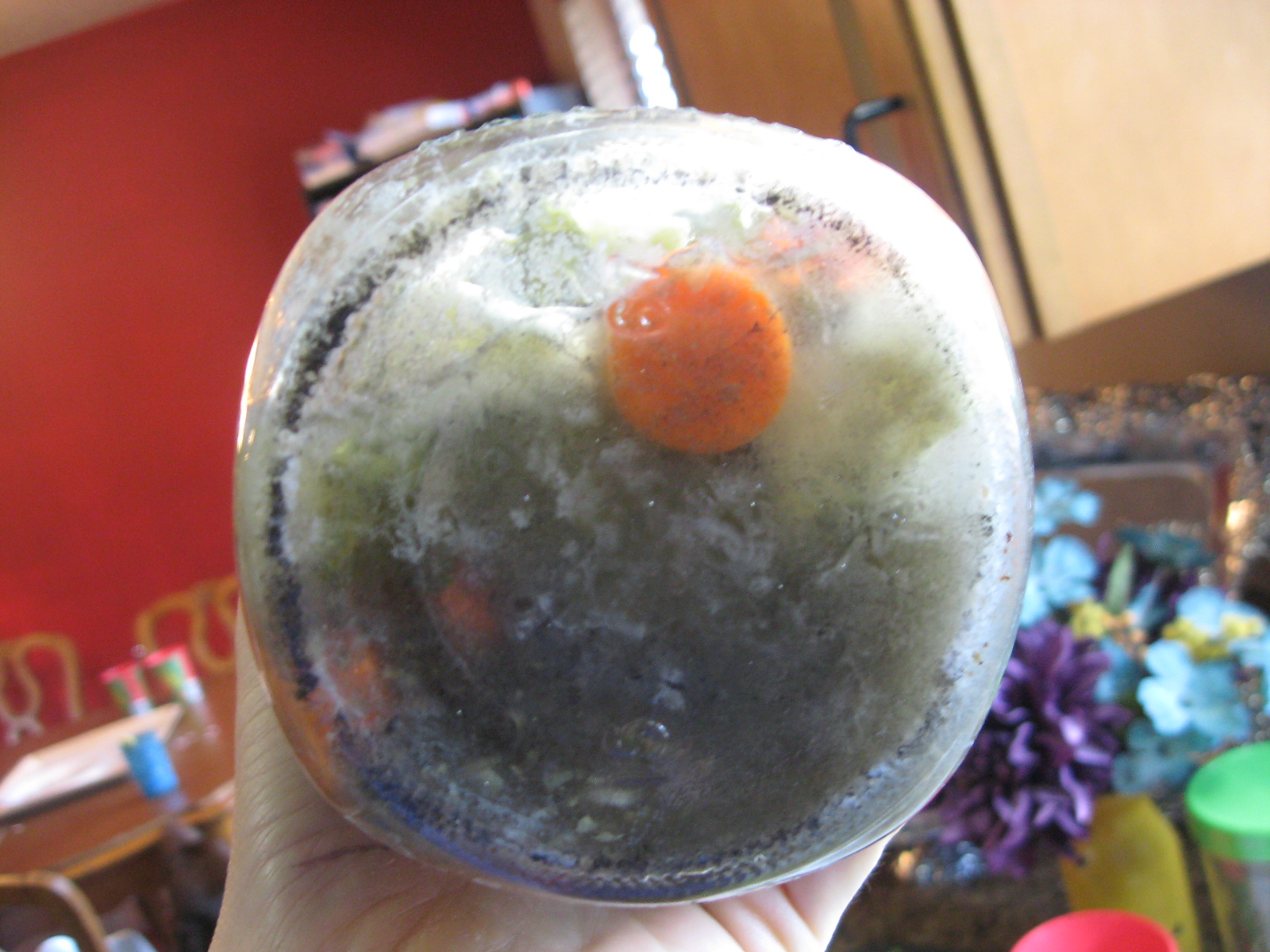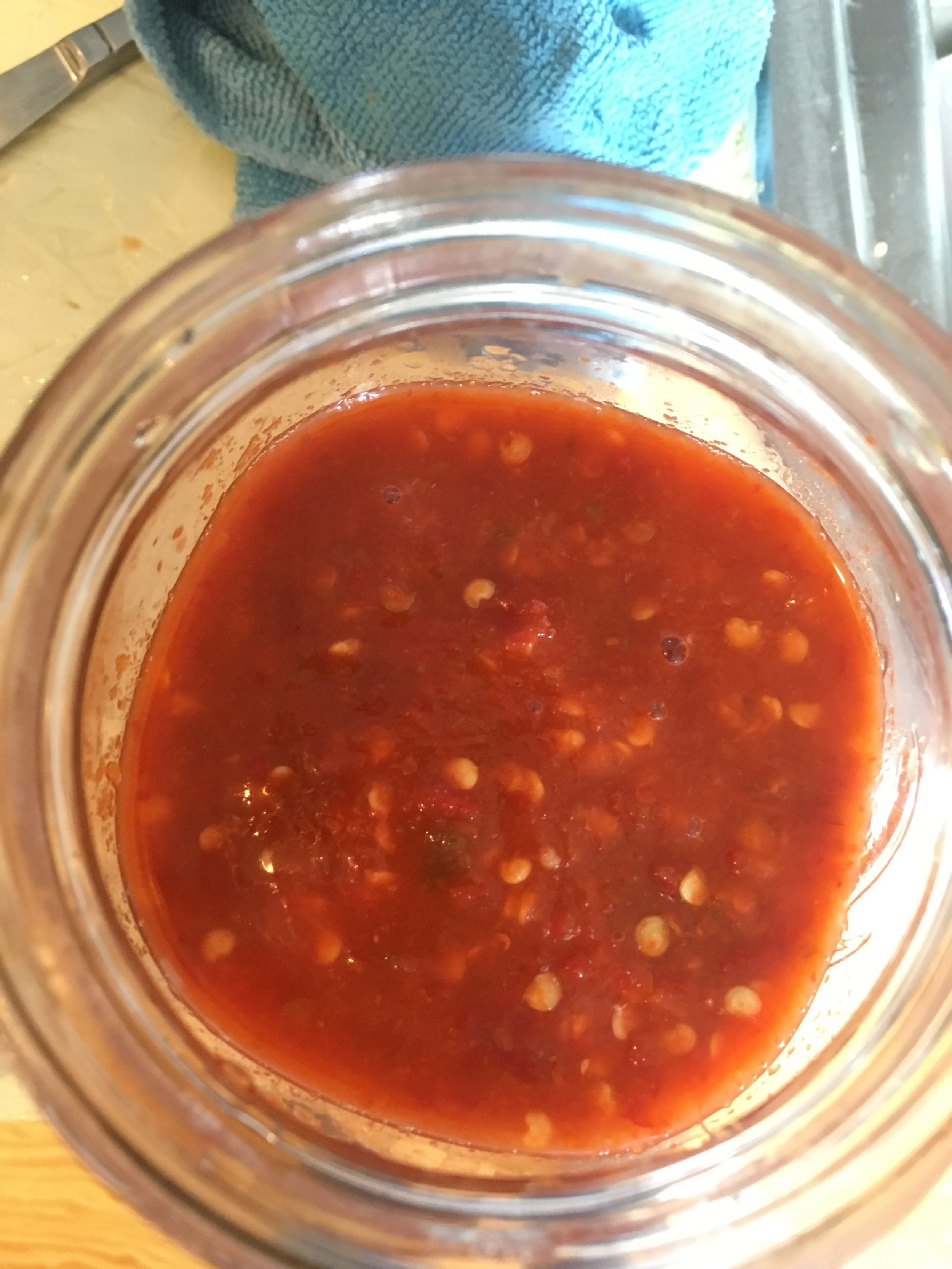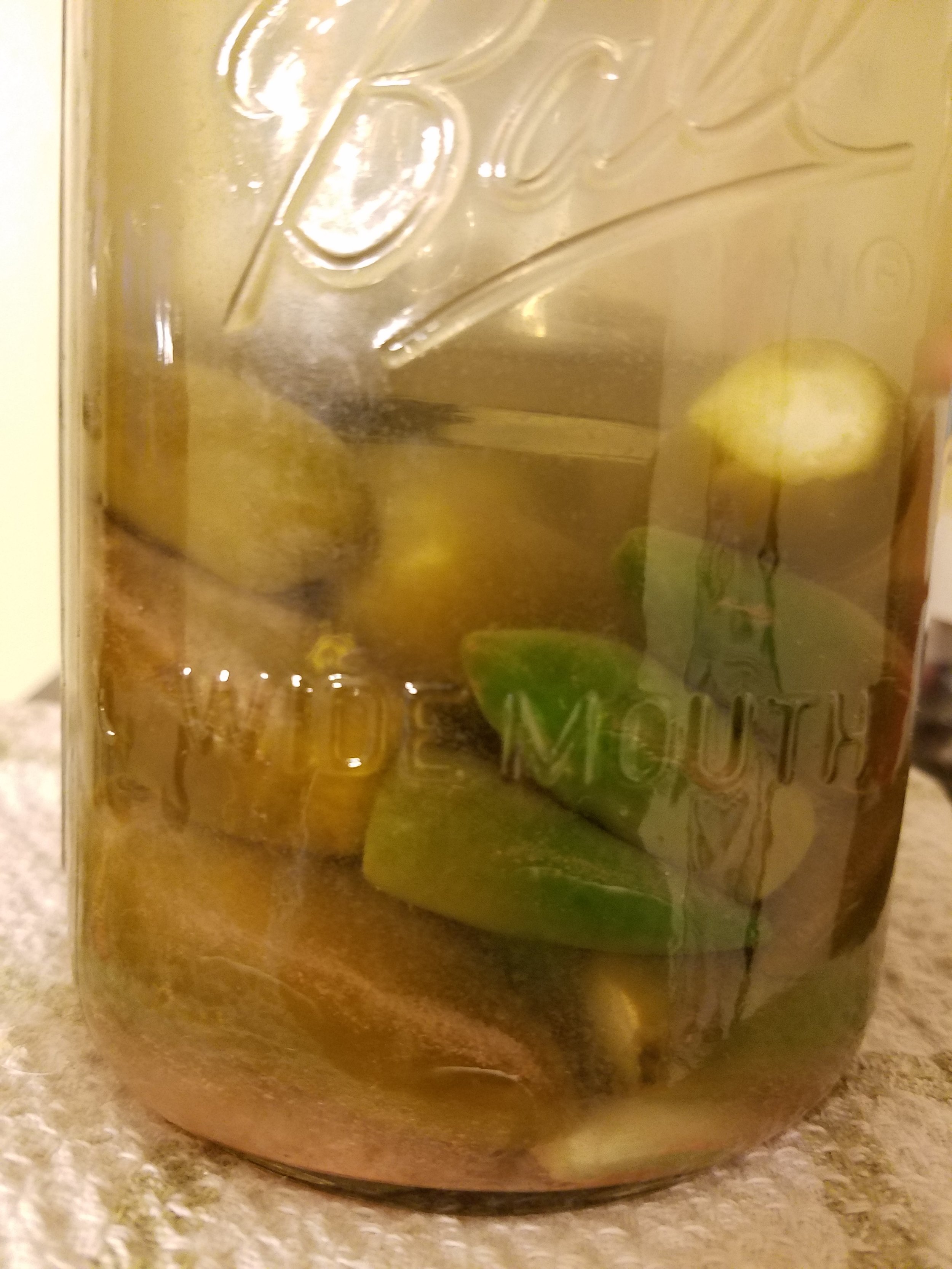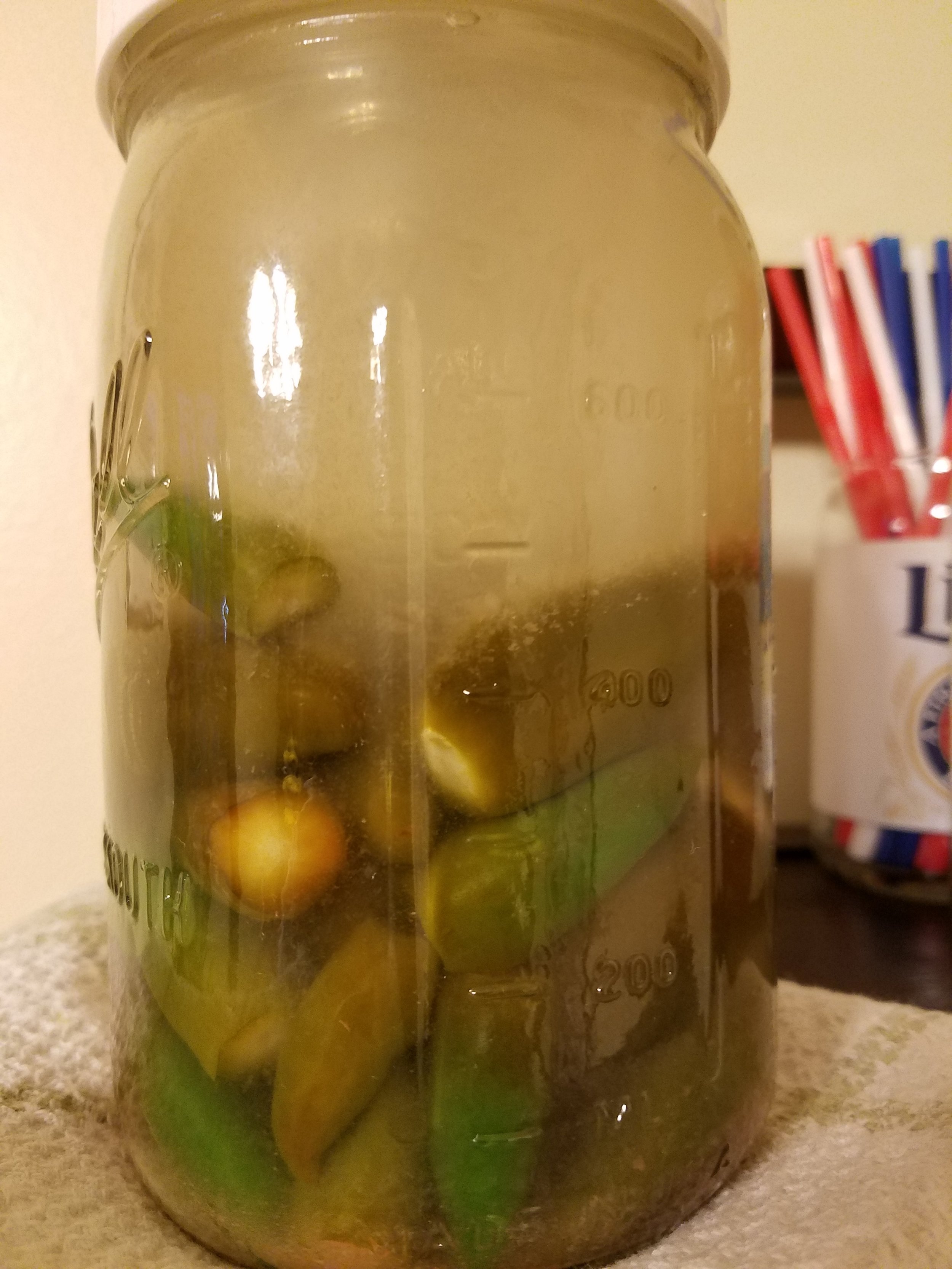Hi Kirsten!
I have a question for you!
Can you tell me why this littles dots on my Pickles is normal? (Pictures are attached) They dont have that before..
The pickles was made the last summer so already 7 months in the fridge.
Also, I find that often, my fermented vegetables are soft. Not crispy (pickles, greens beans, radish...) why ?
I always put a little bit of black tea in the final jar but help to keep their crispiness.
But I need your help!
Thanks!!!
*********************
Hi Carolanne,
Oh dear, those do not look well. I believe this is some kind of fungus. This could happen if even one of the tops of the pickles was peeking out of the brine. That little bit of exposure acts as a vector.
As far as soft ferments, more often than not that is because there is not enough salt in the brine. One of salt’s functions is to harden the pectin in the cell walls and this is what keeps things crispy. Tannins help but you need more salt to begin with.
Cucumbers are especially needy in this regard. Of all the things I ferment cucumbers get the highest salt ratio. They just want to soften otherwise. You want to you a 5% brine.
I hope that helps,
Kirsten
What Causes Blue Mold to Grow on Fermented Pickles in the Fridge?
Hi.
Thanks for your website. I’ve fermented for over 10 years and until last year had delicious pickles. Last year the pickles in my old crock did not taste good, although the texture, firmness and looks were good. This year all four batches were delicious after they’d fermented on the counter., both green beans and cucumbers. I refrigerated them and they were good for a month. Then after being away for a month I found a blue mold on the surface of brine - on all 4 batches in the refrigerator. Same as that batch last year. They looked great, were firm but the taste is like medicine, like mold, after I'd carefully removed the mold. They are not good to eat. The mold is more leather-like than scum. I don’t think they are dangerous to eat, but sure not pleasant to eat. I’m tossing them. What went wrong? Should I invest in the German pickling jars?
*********************
Hi Rebecca,
You are welcome, glad it helps. Goodness do you have some fine mold mats.
It is good that you tossed them. Somehow you you you have gotten some tenacious little mold spores. The thing is they need oxygen to grow, sometimes when you repack a ferment from a crock there is just enough oxygen in the headspace to allow mold to grow. If the ferment is still a little bit active when you repack it you can actually let it sit out for a day with the lid on tight and as the lid bulges a bit then twist it slightly to burp it. This will push out the oxygen as the CO2 the ferment created is heavier an it will now blanket the pickles to keep them from growing mold. As far as do you need different equipment? It is possible that there are some spores that have taken up residence in your older crock and they are what is giving you grief. Also older crocks sometimes have lead in the glazes whereas the newer ones don’t, so that might also be a reason for you to replace. With what? is personal preference the water trap crocks with the weights are nice, but you must be sure to keep the water full, otherwise they are just as prone to mold and other oxygen loving microbes as an open crock. Fermenting is jars is also a great option.
Cheers,
Kirsten
Why Would Fermented Green Tomatoes Appear Slimy?
Not Okay Okay
Hi!
Thanks so much for all your advice and support. I’m not super new to fermenting, but realize I’ve never done a cut, seedy vegetable before (mostly whole cukes, beets, cabbage etc), and notice something odd on this batch of green tomatoes. Some, but not all, of the cut surfaces seem to be acquiring a whitish, slimy looking (although not slimy feeling) bloom. They have been under brine, in a crock, for about 3 weeks, and a few seeds have floated to the surface and caught mold, but I’ve discarded these and everything else seems to be fine. One week ago they smelled and tasted pretty good - thought I’d let them go longer and now they don’t taste as good, and several have this... stuff. Any thoughts?
Thanks in advance!********************
Hi Sara,
You are welcome. I am happy to help! However, I am afraid I won’t be much help on this one. It sounds like you did everything just right and last week all was well. Given they don’t feel slimy, just look slimy, I wonder if they just fermented too long and microbes that moved in were not yummy flavor makers. ou also said they don’t taste as good which to me is another indicator that the microbes shifted on you. This off course is all just an educated guess. I can tell you that in general cut seedy veggies are much quicker to cause problems. I have come to doing my cucumbers and green tomatoes whole (or chopped like relish) for this reason.
As far as this batch, if they are not rotten (sounds like they aren’t) but aren’t pleasing there is not much you can do at this point. If you don’t like them don’t eat them, or make a relish with the ones that are okay and eat it soon.
I hope that helps.
Cheers,
Kirsten
Cabbage Leaves Blackening?
Hi.
I am making sour cabbage leaves for cabbage rolls and using old Baba recipe which is very loosely-goose as to amount of salt and water. Smells like they are fermenting but outer leaves appear to be blackening! Yikes! Why? And are they still salvageable?
Thanks, Kathy
*********************
HI Kathy,
These look okay to me, I don’t see they “blackening” but I do see the deep color I think you are referring to, this is just the color that the greener outer leaves get. Think of the color of an olive or dill pickle. Green turns that army style green.
I think as long as you keep them submerged until they are fully fermented they will be fine.
I hope that helps,
Kirsten
Pink floating bits on top of brine
Onions garlic dill bay leaf and asparagus getting bubbles and red pink floating bits looks like mold
See pic attached thanks
****************
Hi there,
That does look like some kind of unwelcome pink microbial growth. The good news is that you have a great deal of brine and your veggies are anaerobic and safe under the weights.
Skim off the top layer catching all of these bits.
I wouldn’t get into the ferment until it smells good and pickle-y. When it is time make sure that none of this has grown back. If it has skim it off again.
Once you get into your ferment if it smells and looks good it then it is. If it smells off then it is likely off and you will want to send it to the compost.
I hope that helps,
Kirsten
Fermenting asparagus is wonderful. In this post, we walk through a simple pickled asparagus recipe. In this post, it looks like an even bigger amount of asparagus was being fermented.
Pickling vegetables like asparagus and onions is really pretty easy, as you saw from the video above. If you feel that you need more help making your first batch you can pick up a copy of our Fermented Vegetables and we will be happy to sign a copy to you or your friend and ship it out tomorrow. If you would rather see it, really see it, how about a personal online class? Here are a couple of good choices.
Mold on Beet Kvass
Hello Kristen!
I’m taking my first crack at making Beet Kvass and have just a little bit of experience with fermenting. I made three jars like this with slight variations (w/lemon, without lemon; variations on the salt) and this one looks like the seal was letting in some air. They have been fermenting for about a week. The other two jars had some scum but overall seem to be a success. This one makes me pause a bit... the mold does not look good and I’m wondering if the location was a little bit too warm in addition to the questionable seal. However, the beets and liquid below still have their lovely pink color, so I’m hoping you can help. Important to note that there are mint leaves floating at the top, which may distort the color a bit. Thoughts?
Thanks!
Maureen
********************
Hi Maureen,
I am glad to hear your other two turned out well. I can’t imagine your variations have anything to do with the mold, more likely the seal, as you suspect. Also the mint floating on top could have given the mold a place to land, but not caused it.
A few things that you can do to prevent that in the future is to fill the water line a little higher in the jar. Less airspace means that there is less oxygen for the CO2 to push out (whether you are burping the jar or using these one way lids).
As far as this kvass goes. It looks like a pretty big bloom of mold and the ferment hasn’t been going very long so I can’t say with confidence that is as acidic as it should be. My guess is that if you carefully remove it, make sure that you got it and a little of the kvass underneath, and make sure the jar sides are clean, that it may still taste off or moldy. But that is what you would do in order to tell, if what looks good is good or not. In this case my instinct would be to compost it and start over.
I hope that helps,
Kirsten
Gelantinous, thick, milky, fermented garlic brine
Strangely enough both of these letters came within a day of each other sharing the same question regarding a thick fermented garlic brine.
While they look all wrong both these ferments are fine. It happens sometimes with garlic. We don't know the reason behind it but these ferments. It is not mold and we haven't found that it happens from a process error. More likely it has something to do with the variety of garlic. I have done a lot of variety testing and found some varieties do this while others do not. While this brine unsightly, are perfectly safe and taste good as well.
Hello!
What a helpful resource your site as been! Thank you for offering to give us individualized advice.
I’ve had a garlic ferment in my cabinet for about 2 weeks. I’ve checked it every other day. The garlic is completely submerged below 3 clean rocks. I’ve checked the ferment every other day, letting out the air. Today when I checked I noticed this milky white stuff floating at the top ¼ of the jar, more around the rocks, less the garlic. I’m attaching 3 pictures and my attempts to draw lines to what your eyes should focus on.
Is this the start of mold growing? Or is it something else? The ferment has appeared healthy to date, a lot of bubbling every day, and a few cloves have started to turn blue.
Thank you,
Sherry
Hi Kirsten,
I started a batch of fermented garlic and it just hit the 4 week mark. It had been doing great and was bubbling lots, but a few days ago (maybe a week) I noticed that the bubbling had mostly stopped and the brine turned kind of gelatinous. You can see small solid chunks throughout the brine. The smell and color still seem fine, there’s no mold, and I think it’s ok, but am unsure since this is my first long-term brine. Is this safe to eat?
**********************
We've consolidated the answers to both of these into the text above.
Help - what is growing in my kimchi?
Hello - I started kimchi in my crock a week ago. There is an unidentified cloud of growth within the brine - above the weights but below the air surface. Can you help identify what this is? Is the kimchi below still safe to eat?
Thanks!!
Katie
***********************
Hi Katie,
Your unidentified cloud of growth is normal, it is sediment, very normal! This sediment always forms and is just more obvious given that it has the weights that it settles on. Think of the cloudy brine in fermented pickles in Bubbies—it is white in those ferments and red in kimchi because of the spices. I am happy to report that your kimchi looks perfect and delicious!
Yes, you can eat it!
Cheers,
Kirsten
Dark grey sediment in my ferments?
Good morning Ms. Kirsten,
I found your site through a Google search and can't thank you enough for providing the help section! This is our first attempt at fermented vegetables. They have been bubbling, the lids swelled a little and became hard, and they have been seeping (all of which I'm guessing is normal). What wasn't mentioned in the recipe is that the brine developed these grey, sediment-like particles that began floating throughout each jar but mostly settled to the bottoms (looks darker in person than in picture). Each of the 9 jars also developed a dark grey/black ring around the bottom. Is this a normal/safe ferment? When I opened one this morning (day 8) it was hard to open and fizzed, bubbled and sizzled as if it's been fermenting fine and there does not appear to be any discoloration on the cabbage leaves I used to hold the veggies under water. Thank you so much in advance for your time!
Kind regards, Elizabeth
************************
Dear Elizabeth,
We are glad to hear that our site is helpful. You are right all that “action” is quite normal. The sediment is also quite normal—in fact when I see cloudy brine and sediment I know that the process is working well. The black bits of sediment are not normal in and of themselves but I am guessing that they are from a grey Celtic style salt or that they are a spice or herb that your recipe may have called for that has also settled along with the sediment. If you don’t feel that is the case, let me know what was in the recipe and we can look a bit further into it.
As far as the cabbage leaf on top of your 8 day ferment it looks normal to me. I don’t see anything in the photo that concerns me, it does as well as the other photos, look like they are not fully fermented yet. In cooler temperatures 8 days can still be a young ferment — in hot temperatures 8 days can be over fermented. So it depends. If it is ready it should be smelling nice and acidic —pickle-y :) If it does then go ahead and reach under that leaf and taste it. If it is tasty you can put it in the fridge if it isn’t sour enough then close everything up and let it go a few more days.
Remember if a ferment is bad it will let you know—the smell alone will say don’t put me in your mouth.
I hope this helps.
Kirsten
Chili paste fermentation gone...wrong?
Hi, Kirsten,
Thanks for being willing to take a look!
To go along with the pictures I’ll describe how it smells... not great!
Let me know if you need different photos to determine what’s a happening.
Andy
*************************
Good Morning Andy!
You are right the top is nasty and I am sure smells — not great! It looks like a mix of bacterial, mold, and yeast growth that you don’t want. That said, the bottom is totally fine. You also have a nice layer of plastic to help you pull all that off carefully. Once you pull it off, skim the top of the paste until you are at the bright red color that I see in the photo. Also wipe the sides of your jar down with a paper towel. I think you will find that is great underneath. (Remember everything that is anaerobic is fine.)
Hope that helps,
Kirsten
Thanks so much! I did my best to skim first—the plastic was held down by a pair of large weights—and then remove the weights and plastic. I’m sure some of the bacterial/mold/yeast mix is still around... I’ve placed it in a smaller jar. I’m likely going to let it ferment a bit longer before putting it in the refrigerator. Will that make the ferment “stronger” in terms of fighting off bad growth, or is my understanding of fermentation that bad?
Thanks again for the help—I promise not to abuse your inbox!
Andy
*********************
Hi Andy,
This looks great. You are fine and any bits that are left will only grow again if they have access to oxygen.
Your ferment is strong as soon as it is acidic and nothing pathogenic can live in the anaerobic acidic environment, if you get any nasty growth is would be only on the surface.
At this point letting it ferment longer is going to mostly be about flavor. I, of course, don’t know what the acidity is but likely it will not get much more acidic with time. Usually the bulk of the acidity develops in the first few weeks.
I hope that helps, and no worries ask away until you feel like you got it.
Cheers,
Kirsten
Mold on top of fermented leeks
:( I started a batch of fermented leeks from the Gjelina cookbook a few weeks ago. The recipe did not say to make sure the leeks are submerged in liquid, and while I was skeptical about that, I went with it. Now, however, there’s lots of mold on top. My gut reaction was to cry and throw it away, but the I saw your website and thought I’d ask your advice. ~D
*****************
Nice to hear from you! Sounds like you suspected to trust your gut! :) Always submerge with fermentation, no matter what the recipe says, sometimes we writers forget to add details that are second nature to us—
I do see that solid layer of mold on top. It looks like it is the first inch or so of the ferment. Scoop that off and get to the place where the leeks are happily submerged. They should smell and look fine. No tears necessary :)
I hope this helps.
Cheers,
Kirsten
Mold on top of fermentation bag
Hello Kirsten,
I am making my first batch of fermented pickles. The recipe I used had me place a ziplock bag on the top to weigh down the brine. It now is covered in mold. If I remove the bag carefully will the pickles below still be okay?!
Thank you,
Adrienne
***************************************
Hi Adrienne,
The bag is doing its job and keeping the mold off of your ferment. Everything below the brine is fine and I don’t see where the mold has even gotten past the bag.
Just remove the mold carefully, then the bag carefully and you should be golden.
They look great!
Kirsten
Pinkish Sediment on Fermenting Peppers and Irregular Color
Hi Kirsten,
I'm new to fermenting, and as my second foray into it, I have a bunch of jars of various whole peppers fermenting, including the pictured jar of jalapenos and serrano peppers. The rest of the jars seem to be doing well, no cloudiness, no mold, etc, but the jalapeno jar's brine is cloudy, and there seems to be a fine, almost powdery looking, pinkish white sediment on the peppers as well as the bottom of the jar. I also skimmed a little mold off the top of the brine at one point - just a few little pinhead-sized floaties. It still smells alright, peppery and pickle-y and salty. Just wondering if this should be composted or if I should continue the ferment? It's been 2.5 weeks since I started it. Oh, and I used Himalayan pink sea salt to create the brine - could this be what the pinkish color is from?
Any advice you could offer would be wonderful! I can also try and take more or different photos if needed as well.
Stefanie M
*********************************
Hi Stefanie,
Welcome to the world of fermentation! Your ferments look fine. The cloudiness and sediment is a normal part of fermentation. In fact, when I see it along with the color change of the veggie I know things are progressing nicely. You did the right think to skim off the mold and that has nothing to do with the sediment you are seeing. You are probably right that the pink color has to do with the salt. We use Redmond Real salt, which also creates pink sediment.
If it smells pickley that is a good sign also. If it was head for the compost it would smell awful.
The thing that I wonder about is that some of the peppers are still quite green. Did you add a few more peppers after a couple of days in? I am guessing if not they are just slower. The ferment looks done except for those peppers. When then turn dull green it likely will be.
Cheers,
Kirsten
*****************************
Hi Kirsten,
Thank you so much for the information! Glad to hear all is normal with the ferment. All of the peppers were added at the same time, but the Serranos are still bright green as opposed to the jalapenos. Should I remove the finished jalapenos for tasting, or should I wait until the serranos are also finished?
Additionally, the other peppers I have fermenting are yellow, red, or other colors (super hot peppers - peach scorpions, chocolate reapers, etc.). Is there a definite color change that will occur with these as well? They are still quite vibrant.
*****************************
You are very welcome.
No need to remove any peppers. The Serranos are just taking their time, and I do see that they are changing. I was just curious as it is a little unusual to see some that are so different in the same jar. And no you won’t see any color change in the reds and yellows, the chocolate reapers are brown right, those might change a bit. It has to do with the colors being water or oil soluble pigments. Carrots, red peppers, etc. are oil soluble and will not change or “fall out” into the brine. Water soluble colors (the pink in a radish) may color the brine and the veggie will turn dull.
Hope that helps.
Cloudy brine and sediment in my carrot sticks
Hello Kirsten and Christopher,
I recently purchased your book and attempted to make the sauerkraut and fermented carrot sticks. I'm a bit concerned about my carrot sticks. They have a thick cloud and white sediment at the bottom, which I read is normal, but they taste a bit vinegary and are softer than I imagined. They are about 6 days in. Do they look okay and how acidic should they taste?
Thanks,
Ryan
***********************************
Hi Ryan,
Thanks for getting and using our book. It looks like you have a bit of kahm yeast, that is the white stuff on top. It is harmless but likely is the cause of the softer texture. Fermented carrots are not super acidic so it sounds like they taste fine. They look fine from the photos, apart from the yeast. Again this is harmless and it happens sometimes, I would scoop it off as much as you can and then refrigerate. It should go away or at least slow down to a point that it won’t bother you.
All best,
Kirsten
The scum looks funky, is it okay?
Hi,
We started fermenting some red cabbage in a 10L crock about two weeks ago. Over the weekend, my husband realized that he had not checked the water seal on the lid in quite some time, and, alas, it was completely dry. The cabbage has been under weights, but the top of the brine looked pretty funky (see photos). Did we ruin our batch?
Thanks for your advice,
Amanda
******************************
Hey Amanda,
Funky but fine!
When you are ready to eat you will skim that off as best you can, there is actually nothing harmless in that funk that you are looking at, taking the weights out carefully as you go will help you to remove all that.
I am positive you will see a beautiful pink kraut underneath. :)
Cheers,
Kirsten
Fermented Garlic Brine is Blue-Green
Hi Kirsten,
Thank you so much for your kind invitation to send in fermenting issues.
I am an eager newbie to the world of fermenting. Garlic has been my first foray into this world. Please see attached an image of my attempt.
I'm concerned about the colour the brine has turned. It is decidedly green and there is a strong garlic smell emanating from the closed jar. Is this to be expected? I understood the cloves themselves may turn green or blue during the process but not the liquid?
I'd be grateful to know what has happened and what I can do to get a good jar of ferment. Thank you in advance for your assistance.
Kind Regards,
Carol
**************************
Hi Carol,
Ah yes, the blue-green hue. You are right it is a little different seeing it in the brine. My guess is that the brine is thick with the garlic sugars. The whole cloves we make can have a very thick brine and that the blue-green is actually on the garlic that is now in the brine. Sometimes when they sit in the fridge for awhile the blue will work itself through.
This ferment looks okay to me but you be the judge (and trust your gut). If it smells strong like garlic, that is normal, if it smells strong like bad, compost, or whatever, then I would say it is bad. It should also smell a bit pickle-y.
It doesn’t always happen so don’t be discouraged and again I think they are fine, when you are ready to taste them, you will know. Pickle-y acidic garlicky is good, any thing else is not.
Cheers,
Kirsten

